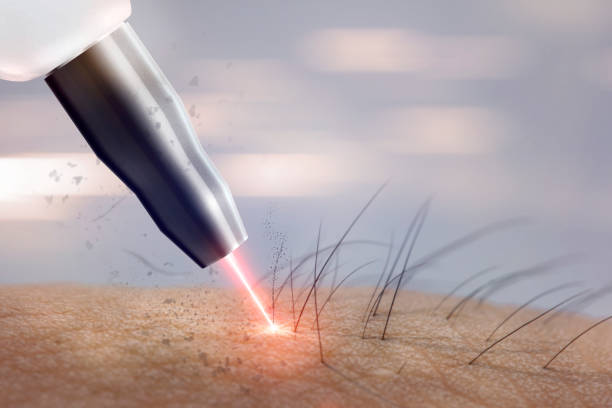After a laser hair removal treatment, you may notice some shedding of hair in the treated area. This typically occurs within 1 to 3 weeks after the session. However, it’s important to note that not all hair will fall out immediately after the treatment. Some hair may take longer to shed or may require multiple sessions for complete removal.
The laser targets the hair follicles, damaging them to inhibit future hair growth. The shedding of hair is a natural part of the process as the treated follicles are expelled from the skin. It’s important to follow the recommended treatment schedule provided by your dermatologist or laser technician to achieve optimal results.

Why does it take a week for hair to fall out after laser?
After a laser hair removal treatment, it takes some time for the hair to fall out due to the natural hair growth cycle and the way laser hair removal works. Here are the reasons why it may take about a week for the hair to shed after laser treatment:
- Hair growth cycle: Hair follicles go through different phases of growth, including the anagen (active growth), catagen (transitional), and telogen (resting and shedding) phases. Laser hair removal is most effective during the anagen phase when the hair follicle is actively producing hair. Not all hair follicles are in the same phase at the same time, which is why multiple sessions are required for optimal results. After the laser treatment, the targeted hair follicles gradually move into the shedding phase, and it takes time for the hair to loosen and fall out.
- Hair follicle response: The laser used in hair removal treatments targets the pigment (melanin) present in the hair follicles. The laser energy heats and damages the follicle, impairing its ability to produce new hair. While the hair follicle is still intact immediately after the treatment, the damaged follicle gradually weakens over time. This weakening eventually leads to the shedding of the treated hair.
- Individual response and hair growth rate: The rate at which hair sheds after a laser treatment can vary from person to person. Factors such as hair thickness, density, and individual response to the treatment can influence how quickly the hair falls out. Some people may experience faster shedding within a few days, while others may take longer, up to a few weeks, for the treated hair to completely shed.
It’s important to note that not all hair will fall out immediately after the treatment. Multiple sessions are typically required to target hair follicles in different growth phases and achieve long-lasting results.
Is it safe to pull out loose hairs after laser hair removal?
It is generally not recommended to forcefully pull out or pluck loose hairs after laser hair removal. While it may be tempting to remove the hair, doing so can interfere with the natural shedding process and potentially cause harm to the treated area. Here are a few reasons why it is advised to avoid pulling out loose hairs:
- Disrupting the hair growth cycle: Laser hair removal works by targeting the hair follicles to impair their ability to produce new hair. When you pull out a hair, you may disrupt the natural growth cycle of the hair follicle. It may start a new growth cycle prematurely, potentially making the hair removal process less effective in the long run.
- Potential skin damage: Forcefully pulling out a hair after laser treatment can irritate and damage the skin. The treated area may be sensitive or susceptible to inflammation immediately after the procedure. Pulling out hairs can lead to skin irritation, redness, or even the formation of scabs.
- Risk of infection: When you pluck a hair, there’s a small risk of introducing bacteria or causing a minor skin injury. This can potentially lead to an infection in the treated area, which is something you want to avoid.
If you notice loose hairs after laser hair removal, it is generally best to let them naturally shed on their own. You can gently exfoliate the area using a soft washcloth or a mild scrub to encourage the shedding process. If you have concerns or questions about the hair shedding process or post-treatment care, it’s always a good idea to consult with your dermatologist or the healthcare professional who performed the laser hair removal procedure. They can provide personalized advice based on your specific situation.
Can I shave 24 hours after laser?
The timing for shaving after laser hair removal can vary depending on the specific instructions provided by your healthcare professional or dermatologist. In general, it is often safe to shave the treated area 24 hours after a laser hair removal session. Shaving helps to remove the hair above the skin’s surface without plucking or pulling out the hair follicles, which can interfere with the effectiveness of the laser treatment.
Shaving the area prior to the next session can also help to enhance the effectiveness of subsequent treatments. By removing the hair above the skin’s surface, the laser can better target the hair follicles during the next session, maximizing the treatment’s efficiency.
However, it’s essential to follow the specific guidelines given to you by your healthcare professional. They may provide tailored instructions based on the type of laser used, your skin type, and the specific area being treated. If you have any concerns or questions about shaving or post-treatment care, it’s best to consult with your healthcare professional who performed the laser hair removal procedure. They can provide you with the most accurate and personalized advice based on your unique circumstances.
How can I speed up shedding after laser?
While the shedding process after laser hair removal is a natural part of the treatment, there are a few things you can do to potentially help speed up the shedding of treated hairs. Keep in mind that individual responses to laser hair removal can vary, and these suggestions may not guarantee faster shedding in all cases. Here are some tips that may assist in the shedding process:
- Gentle exfoliation: Gently exfoliating the treated area a few times a week can help encourage the shedding of treated hairs. Use a mild scrub or a soft washcloth to gently remove dead skin cells and promote the natural shedding process. However, be cautious not to scrub too vigorously or irritate the skin.
- Moisturize the skin: Keeping the treated area well-moisturized can help the skin stay healthy and facilitate the shedding process. Choose a gentle, non-comedogenic moisturizer and apply it to the treated area regularly to maintain proper hydration.
- Avoid excessive heat: For a few days after the treatment, it’s advisable to avoid hot baths, saunas, steam rooms, or activities that can cause excessive heat and sweating in the treated area. Heat can potentially aggravate the skin and delay the shedding process.
- Avoid plucking or waxing: As mentioned earlier, refrain from plucking or waxing the treated hairs. These methods can interfere with the shedding process and may affect the long-term effectiveness of the laser hair removal treatment.
- Be patient and follow the recommended treatment schedule: It’s important to remember that shedding occurs gradually over time, and it may take a few weeks for all treated hairs to fall out. Follow the recommended treatment schedule provided by your healthcare professional and be patient with the process.
If you have any concerns or questions about the shedding process or post-treatment care, it’s best to consult with your healthcare professional or the specialist who performed the laser hair removal procedure. They can provide you with personalized advice and guidance based on your specific situation.
